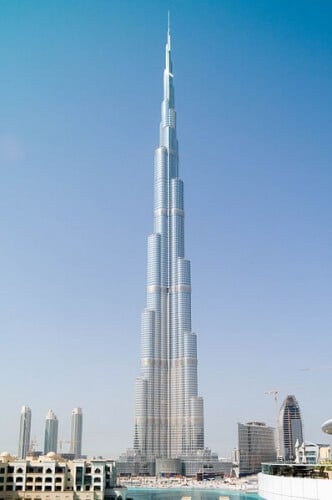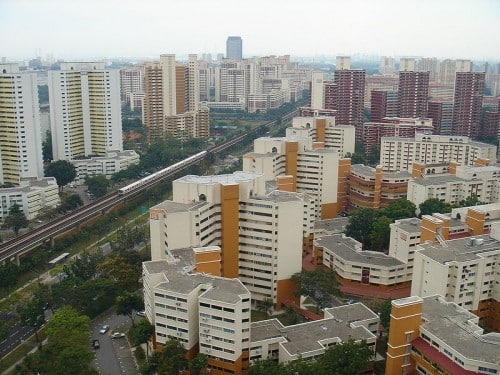More and more skyscrapers are being built in recent years, but not only. Humans have always wanted to reach higher, and evidence of this can be found in the story of the Tower of Babel as well as in the pyramids in Egypt and South America. on the tallest towers in the world

Written by: Ariel Kers, Young Galileo
In my travels with my son in honor of his Bar Mitzvah, I arrived in the huge city of Chicago in the state of Illinois, United States. As part of the entertainment in the city I decided to do something I've wanted to do for a long time: climb to the top of a skyscraper. Chicago is home to the Willis Tower, one of the tallest buildings in the world. In the past, this tower was called Sears, and it was considered the tallest building in the world between 1973, the year its construction was completed, and 1998, when the construction of the Petronas Towers in Malaysia was completed, which took it's premiership. When I became interested in skyscrapers as a child, Sears was the tallest building in the world, and it impressed me greatly with its enormous size, massive shape and black color.
When we arrived in Chicago we already saw from afar the mighty sight of the Willis Tower. It is a huge office building, radiating power and strength, like many skyscrapers. Its height is 443 meters, it has 108 floors, and on top of it are two tall television antennas. The building as a whole (including the antennas) rises to a height of 527 meters, that is, more than half a kilometer in the air.
When you get to the tower during the tourist season, you join a long line of people who want to go up to the top in a fast elevator. Up there is a 360-degree observation deck (called Sky Deck - Sky Platform) of the vast city of Chicago and far beyond. From the top of the tower you can also see the city of Gary in the neighboring state of Indiana, and on a day of good visibility (we were lucky) also the other side of the mighty Lake Michigan, on whose shores lies the city of Chicago. More than a million tourists visit the tower a year. A few years ago, they opened glass balconies with a transparent floor in Sky Deck. These are strong glass cubes that protrude from the wall of the building. When you step into the content, it will seem to you as if you are floating in the air, at a height of 412 meters, above the city of Chicago.

History in the sky
Since time immemorial, man has aspired to reach higher - for many reasons, such as a desire to look down from above and control territories or passageways, an aspiration to get closer to the gods who, according to belief, live in the sky, predict the weather or watch the stars. Man began to build higher and higher buildings, according to the level of technology he had.
The ziggurat (Akkadian: zukur, protruding) was a structure with a wide base that narrowed upwards (like a small mountain), which reached enormous dimensions and heights of tens of meters. Ziggurats were established in Mesopotamia (modern-day Iraq) from 2,500 BC to the fifth century BC. Some of them were built in a structure with a square base like a pyramid (in Egypt, and then in South America), and others, mainly the later ones, in a structure with a round base. The ascent to the ziggurat was on staircases built outside the building. The contents of the tower were empty or filled with dirt. Their purpose was a ritual, and an addition to the pride of all the city's residents, and it is also possible that the tower allowed the city's prisoners to escape to the heights during a flood, which was a common phenomenon in the region. The Great Pyramid of Hufu in Giza, Egypt (near Cairo) rises to a height of about 147 meters. Even today it looks impressive - so try to imagine what the people of the ancient world thought of it.
In the Bible, it is told about the Tower of Babel, which was probably a gigantic ziggurat: "And a man said to his neighbor, Let it be made white and burned to burn; And the brick was to them stone and the clay was to them clay. And they said, "Let us build a city and a tower with its head in the sky, and let us make a name for us spread over the face of the whole earth" (Genesis XNUMX:XNUMX-XNUMX).
In ancient times and later in the Middle Ages, tall pagodas were built in the Far East, and in Europe - cathedrals with impressive towers. But the construction technology of the time, without steel, made it possible to reach heights of approximately one hundred meters. The buildings were made of stone, concrete and a lot of wood. In cathedrals such as those in Ulm (Germany) or Lincoln (England), the towers of the buildings ended with an ornate tower or a high mast, which reached a height of approximately 160 meters. This height is slightly higher than the square Azrieli Tower in the center of Tel Aviv, and it was the highest height reached by the builders before the twentieth century.
The exception, which probably indicated the modern future, was the Eiffel Tower in Paris, the capital of France. The Eiffel Tower is built of iron foundations and rises to a height of 324 meters. It was built in 1889, and although it was controversial because of its strange shape, it soon became the symbol of the city of Paris and one of the most famous sites in the world. The tower was named after the engineer Gustave Eiffel who built it, and today it is visited by about six million tourists a year.
The Eiffel Tower was built for a world exhibition, and is not particularly useful, except for tourism purposes and the location of broadcast antennas. In the XNUMXth century, engineers began to design huge towers in the centers of the cities that were growing - for residential purposes and mainly for work purposes, as office buildings. Today, skyscrapers are the most prominent features in the landscape of many cities. The massive towers erected en masse in the world's important cities are considered the pinnacle of man's technological achievements, and not by chance.
To define skyscrapers, let's start with a height of one hundred meters - not very low, right? Still, many people today would consider a building that is a hundred meters tall as a nice high-rise, since there are usually much taller towers in its immediate vicinity. Modern skyscrapers rise to a height of 400, 500 or even 600 meters. The tallest skyscraper in the world today is the Burj Khalifa in Dubai, which rises to a height of 828 meters and is built using a method similar to the one in which the Willis Tower was built.
What allowed the skyscrapers to grow?
The most important technological improvement that led to the construction of skyscrapers was the elevator. Without it, it was impossible to reach the higher floors. Most people find it difficult to climb five or six stories on foot, so imagine what happens when you try to climb a hundred stories... Construction technologies have also been advancing. The reinforced concrete - that is, cast concrete reinforced with steel, steel beams and lighter construction materials, made it possible to build higher and stronger towers and more resistant to shocks than those built of wood or bricks. Besides that, humans always compete with each other, and big cities like Chicago and New York competed with each other to build the tallest tower in the world.
As in the case of the Willis Tower, most of the tallest towers built in the twentieth century are in America. But in the 21st century, the premiere moved to the countries of the Persian Gulf and East Asia. The tallest skyscrapers are currently being built in the major cities of China, Japan, South Korea, Malaysia and Taiwan. Most of the skyscrapers used to be large office buildings, but today they are also used for residences, and they have hotel rooms, conference halls, observatories, shops and tourist sites. The latest technologies allow engineers to give the skyscrapers special and interesting shapes such as a sail or a pagoda, to use curved lines and more.
It is impossible to build a skyscraper without considering the forces acting on it. The huge cathedrals of the Middle Ages did not always withstand the loads placed on them due to their size and height, and some of them collapsed. Different types of forces act on the skyscraper, such as the weight of the building itself, the weight of the building's contents, temperature changes, storms, lightning or gales. Earthquakes and even terrorist attacks are some of the dangers lurking in it. On September 11, 2001, two skyscrapers called the Twin Towers in New York collapsed (they rose to heights of 415 and 417 meters) following a murderous terrorist attack. The terrorists hijacked two passenger planes, flew them into the towers and destroyed them. About 3,000 people were killed. Two years ago, in November 2014, the "Liberty Building" was inaugurated at the site, which is 541.3 meters high, and is the tallest building in the United States.
In order to stabilize the skyscrapers, they build extremely deep and wide foundations in the ground. The engineers give the towers shapes that are designed to help them cope with the strong winds that blow in Rome. In Taipei, the capital of the island of Taiwan, Taipei 101 was built - a skyscraper at a height of 509 meters, on the 92nd floor of which is located a huge weight weighing 730 tons, this helps to stabilize it during earthquakes and strong typhoons, a fairly common thing on the island near the coast of China.
Skyscrapers in Israel
When I was a child there was only one skyscraper in Israel - Migdal Shalom. The tower was built more than fifty years ago on Herzl Street in Tel Aviv, and is about 120 meters tall. We would go up to its top for a view of the city of Tel Aviv. For many years Migdal Shalom was considered the tallest building in the Middle East. It held the title of "the tallest building in Israel" until 1999, when skyscrapers began to be built in Israel at a dizzying pace, especially in the Tel Aviv and Ramat Gan area, most of them office buildings. In 1999, the Azrieli Towers were inaugurated in Tel Aviv, and the title "the tallest tower in Israel" was transferred to the Round Tower, which is 187 meters high. Two years later, the Moshe Aviv Tower in Ramat Gan was inaugurated, which is 235 meters high, and it retains the title of "the tallest building in Israel" to this day. In Israel there is a shortage of land for construction, and therefore the trend towards building more skyscrapers will probably continue in the future as well.
Did you know?
special types
Some people have Spider-Man type abilities. These people specialize in climbing skyscrapers. On May 25, 1981, a man named Dan Goodwin managed to climb the Sears Tower (today's Willis Tower), dressed in a Spider-Man costume and using hooks and suction cups. In August 1999, the Frenchman Alain "Spiderman" Robert climbed to the top of the tower, without any safety equipment. do not try this at home!
The article was published in the Galileo Young Monthly for curious children. For a gift digital sheet Click

2 תגובות
At my house, my wife climbs on top of me without any safety measures. She is already on the 999th floor.
Bottom line: we don't have a skyscraper at home, so we won't try it.